Introduction
In a world inundated with data, the ability to transform information into actionable insights is paramount for organizations striving to maintain a competitive edge. Data analytics has emerged as a powerful tool, enabling businesses to navigate the complexities of their operations and make informed decisions.
However, the journey towards effective data utilization is fraught with challenges, including data integrity issues and the fear of adopting advanced technologies like artificial intelligence.
By understanding the different types of data analytics—descriptive, diagnostic, predictive, and prescriptive—organizations can unlock the full potential of their data, driving operational efficiency and fostering innovation.
This article delves into the nuances of each analytical type, providing practical strategies for overcoming common obstacles and leveraging data to achieve strategic goals.
As the landscape of data technologies continues to evolve, embracing these insights will be essential for organizations aiming to thrive in an increasingly data-driven world.
Understanding Data Analytics: An Overview
Information analysis includes the systematic computational examination of information, utilizing statistical and logical methods to describe, summarize, and compare information sets. In a time when information is plentiful, companies are increasingly utilizing various types of data analytics to derive actionable insights that promote informed decision-making, improve operational efficiency, and encourage innovation. Nevertheless, challenges like inconsistent, incomplete, or flawed information can result in AI implementation stagnation, hindering companies from completely utilizing the capabilities of their information.
Many organizations perceive AI projects as time-intensive, costly, and complex, which further exacerbates their hesitance to adopt these technologies. As emphasized in a recent analysis of information traits, companies dependent on insight-driven conclusions must prioritize information integrity for effective decision-making. A compelling case study on a mid-sized company illustrates how implementing GUI automation transformed their operations; by reducing entry errors by 70% and accelerating workflow efficiency by 80%, they overcame significant barriers to operational success.
Additionally, the overall worth of investments in FinTech firms globally in 2022 reached $226.5 billion, an increase from $127.7 billion in the prior year, highlighting the increasing dependence on types of data analytics for fostering business success. The emergence of technologies like web scraping has transformed the extraction and enhancement of Points of Interest (POI) information, ensuring precision and promptness in analysis. As we look toward 2024, the latest trends in types of data analytics indicate a growing emphasis on automation and the integration of robotic process automation (RPA) to streamline routine tasks, thus further enhancing operational efficiency.
Significantly, 68% of individuals who do not utilize information analysis are Gen X or Baby Boomers, emphasizing a generational gap in the adoption of such tools. Adopting information analysis through different types of data analytics is not merely an option but a requirement for enterprises seeking to utilize their information for strategic efforts and operational enhancements, particularly in addressing the concerns linked to AI accessibility.
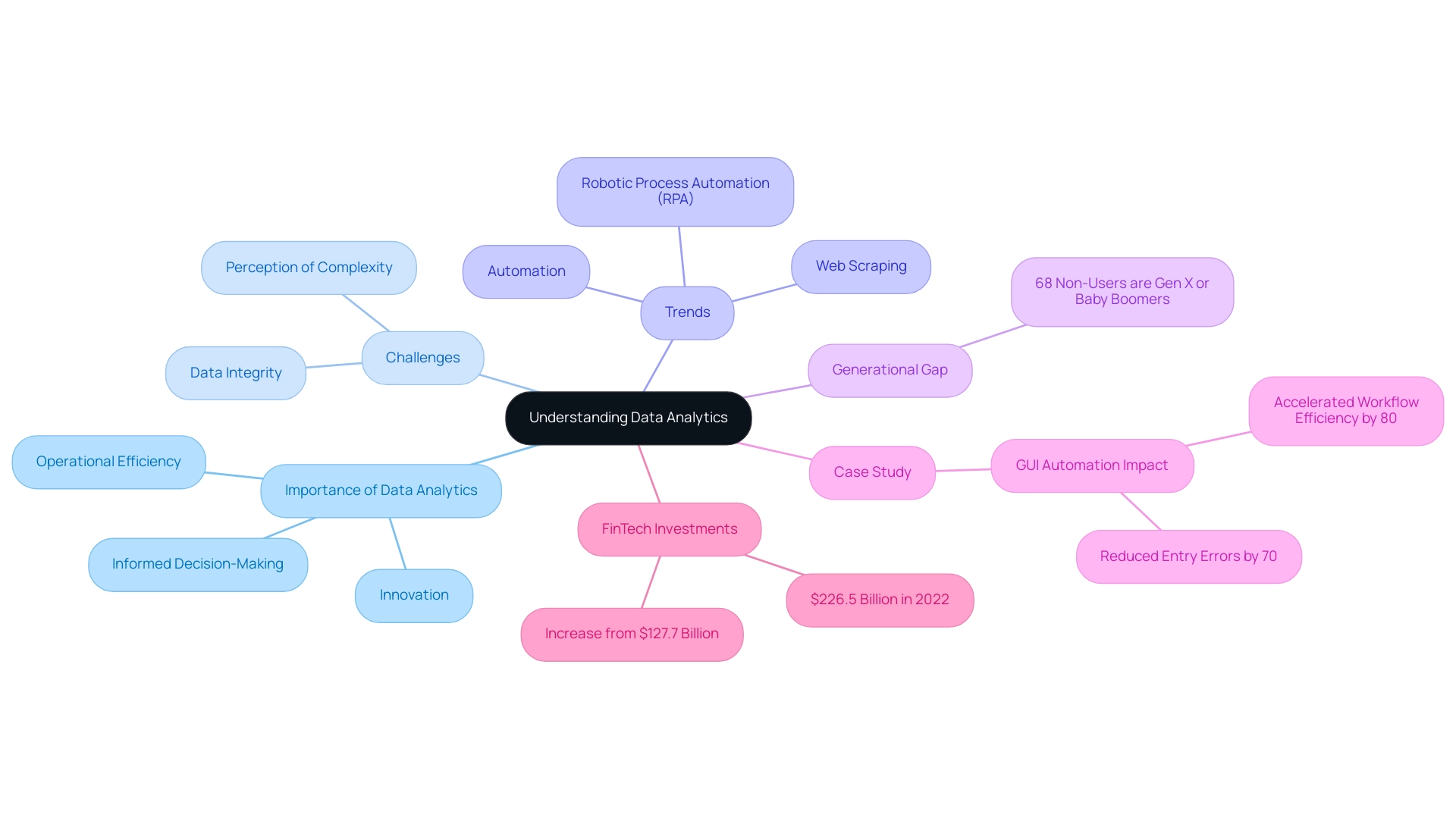
The Four Main Types of Data Analytics: Descriptive, Diagnostic, Predictive, and Prescriptive
In the field of information analysis, organizations can utilize four main types, each serving a specific purpose:
- Descriptive Analytics: This foundational type focuses on analyzing historical information to uncover trends and patterns, enabling businesses to understand what has happened over time. By distilling complex datasets into actionable insights, descriptive analysis lays the groundwork for informed decision-making. As we approach 2025, it’s estimated that consumers will possess a 36% share of information, highlighting the importance of these insights.
- Diagnostic Analytics: Building on descriptive insights, diagnostic analytics delves into past performance to elucidate the reasons behind certain outcomes. This type is essential for organizations seeking to comprehend the ‘why’ behind their information, facilitating more strategic responses to challenges faced. It is noteworthy that 85% of Singaporean business leaders experience decision distress but believe that information can enhance decision-making and reduce risk.
- Predictive Analytics: Utilizing statistical models and machine learning techniques, predictive analytics forecasts future outcomes based on historical information. This forward-looking approach empowers organizations to anticipate market changes and adapt strategies proactively, reducing uncertainty in decision-making processes. Utilizing AI technologies, such as tailored Small Language Models for efficient analysis and enhanced privacy, along with GenAI workshops for custom GPT creation, can significantly improve predictive capabilities and enhance quality.
- Prescriptive Analytics: This advanced type goes beyond prediction by recommending specific actions based on information analysis. By simulating various scenarios, prescriptive analysis guides organizations in making informed choices that align with their strategic goals. The integration of Business Intelligence tools, such as Power BI services—which include a 3-Day Power BI Sprint for quickly creating professionally designed reports and a General Management App for comprehensive management and smart reviews—allows for enhanced reporting and actionable insights, further aiding in operational efficiency.
As the landscape of information technologies expands—driven by innovations like the Internet of Things (IoT), which is projected to generate a staggering 79.4 zettabytes of information by 2025—the significance of these analytical types becomes increasingly essential. The exponential growth of information technologies is being driven by new advancements that enhance transmission, reception, and storage, as illustrated by the IoT’s contribution to the volume of big information generated. With 57% of enterprises appointing a chief information officer and 59% employing system administrators, the necessity to integrate these insights effectively into operations has never been clearer.
Embracing all four types not only enhances organizational efficiency but also positions companies to harness the full potential of their data-driven strategies, including streamlined workflows through Robotic Process Automation (RPA) and tailored AI solutions that navigate the overwhelming technology landscape.
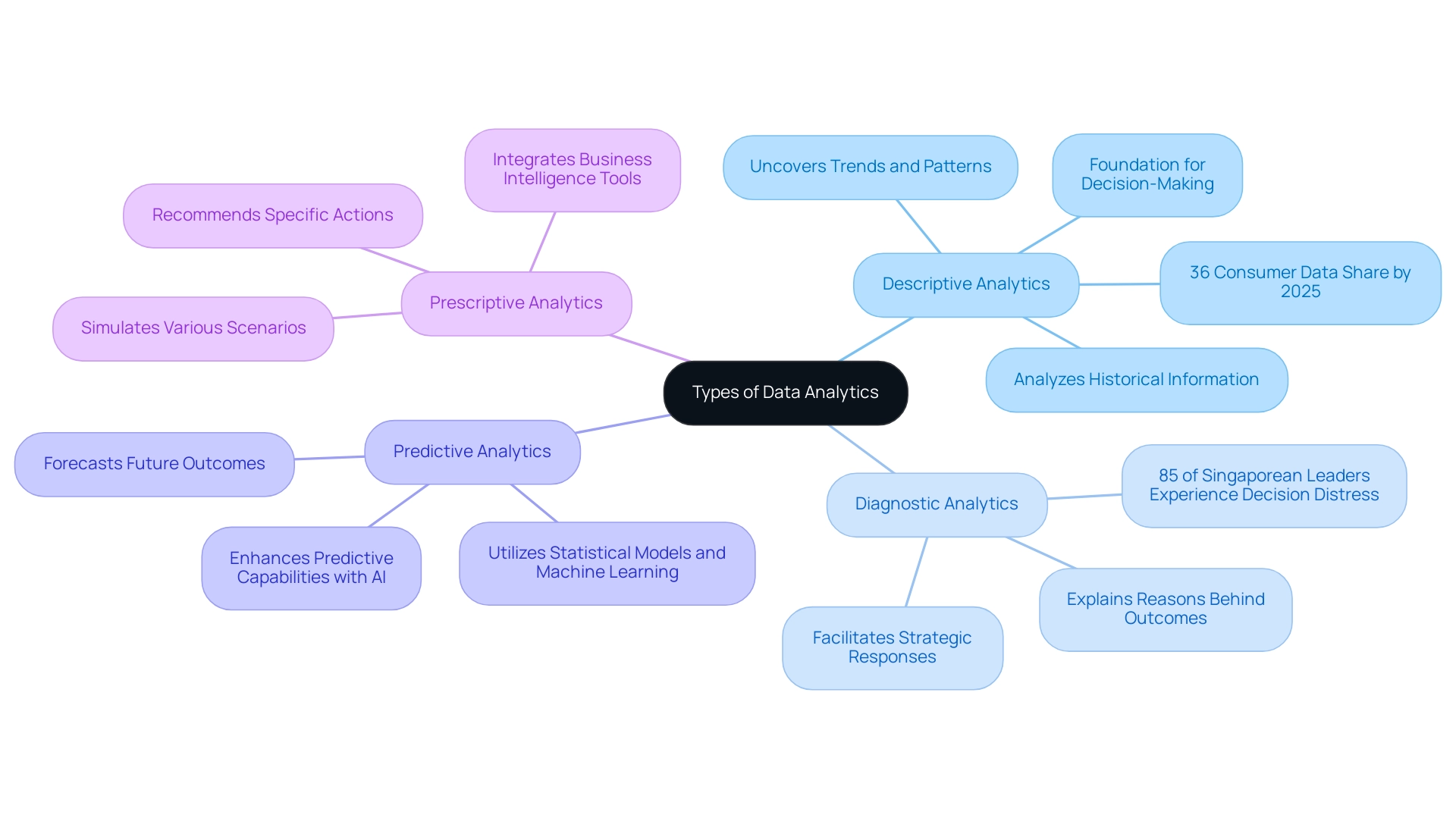
Descriptive Analytics: What Happened and Why It Matters
Descriptive analytics is one of the types of data analytics that plays a crucial role in organizational intelligence, concentrating on summarizing historical information to offer insights into past performance. In an era where the AI landscape can feel overwhelming, businesses often struggle to identify the right technologies that align with their specific needs. Utilizing customized AI solutions is essential for cutting through the noise and ensuring that entities can effectively employ information.
By utilizing advanced information visualization techniques—such as dashboards and comprehensive reports—companies can present insights in an easily digestible format. For instance, a retail organization might examine last year’s sales figures to uncover trends and seasonal patterns, enabling evidence-based decisions for future strategies. Recent studies indicate that retailers utilizing types data analytics are significantly more effective, with marked improvements in their marketing efforts.
Significantly, 54% of companies are considering using cloud-based BI tools in their analytics, underscoring the growing acknowledgment of its significance. A successful example is Narellan Pools, an Australian swimming pool manufacturer, which gathered and examined five years of marketing information, leading to a 23% rise in sales in one year while utilizing only 70% of its media budget. This illustrates the critical significance of historical information analysis in driving operational efficiency and enhancing decision-making processes.
Additionally, Netflix’s use of data analysis illustrates the potential for significant cost savings, achieving $1 billion in savings each year through effective data utilization. As the data analysis landscape evolves, adopting descriptive analysis types data analytics is not merely beneficial but essential for businesses aiming to thrive in a competitive market.
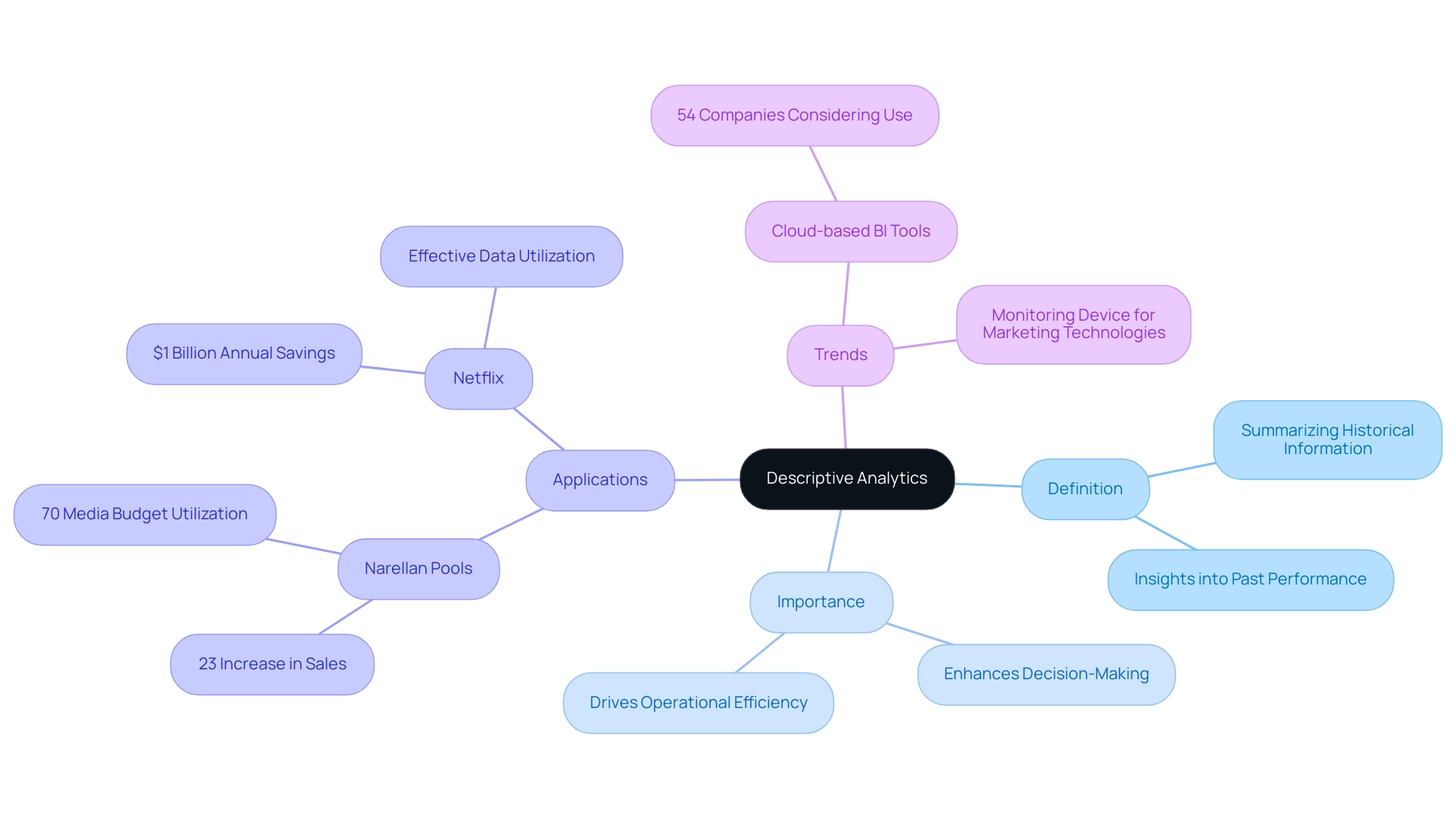
Diagnostic Analytics: Why Did It Happen?
Diagnostic analysis elevates the analytical process beyond mere description by delving into the factors that drive past outcomes. This approach utilizes sophisticated techniques, including data mining and correlation analysis, to reveal the intricate relationships between various variables in different types of data analytics. For example, when a company notices a sales decline, diagnostic analysis can identify contributing factors such as changes in customer preferences or issues in marketing strategies.
According to a survey conducted in December 2021:
- 90% of organizations utilize cloud-based applications, which emphasizes the technological environment that supports types of data analytics.
- A remarkable 81% of companies assert that information should be central to their decision-making processes, underscoring the necessity of these insights.
MedStar Health exemplifies this application through its collaboration with Zephyr AI, where they leveraged de-identified type 2 diabetes information to enhance predictive analytics capabilities.
As MedStar Health emphasizes, understanding the underlying ‘why’ behind these events is crucial for organizations to devise targeted strategies to rectify issues and improve performance. To further amplify these insights, leveraging Robotic Process Automation (RPA) can streamline the collection and analysis of information, significantly reducing errors and freeing up teams to focus on strategic initiatives rather than manual tasks.
Leading players in the industrial data analysis market, including:
- Robert Bosch GmbH
- Hitachi Ltd.
- Amazon Web Services
- Siemens AG
- Microsoft Corporation
are at the forefront of deploying such solutions, driving innovation and market growth.
As the environment of diagnostic examination continues to advance, keeping up with the latest information mining techniques and integrating RPA will be essential for operational success, especially for Directors of Operations Efficiency confronting the challenge of optimizing workflows and improving decision-making processes using types of data analytics.
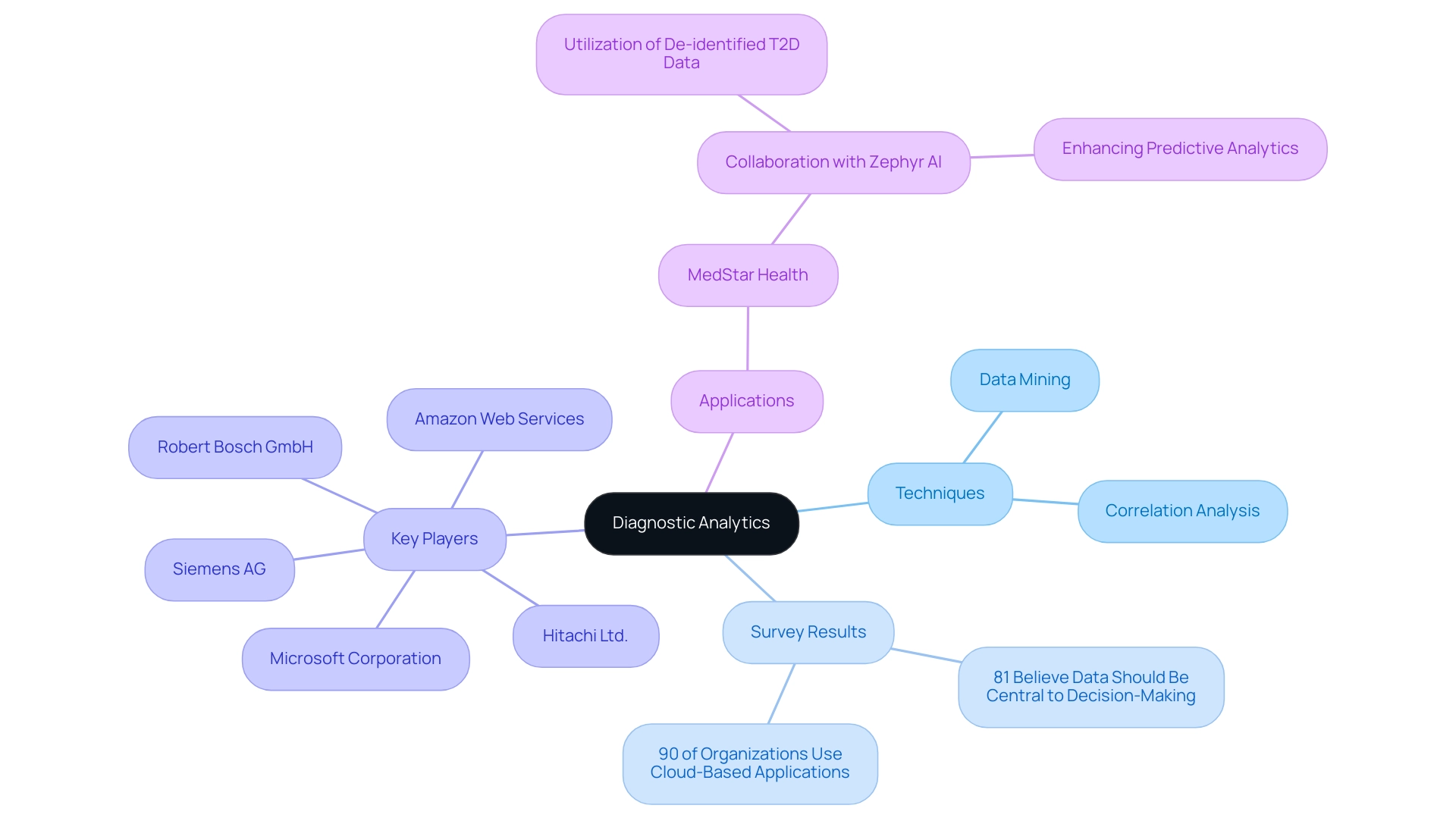
Predictive Analytics: What Will Happen Next?
Predictive analysis harnesses the power of statistical algorithms and advanced machine learning techniques to forecast future outcomes by examining historical data. For instance, financial institutions can leverage predictive data analysis to evaluate the risk of loan defaults by scrutinizing past borrower behaviors. This approach not only allows organizations to anticipate potential challenges but also to capitalize on emerging opportunities within types of data analytics, thereby significantly enhancing strategic planning and operational efficiency.
With the services revenue in this sector projected to reach $24.0 billion by 2032, the financial implications of predictive analytics are becoming increasingly evident. Furthermore, as businesses adapt to a rapidly evolving AI landscape, tailored AI solutions, including Small Language Models and GenAI Workshops, along with Robotic Process Automation (RPA), are essential for driving productivity. For example, organizations can streamline workflows through RPA, automating manual tasks to reduce errors and free up resources for more strategic initiatives.
This synergy between predictive insights and RPA is crucial for informed decision-making and operational excellence. Significantly, with the Natural Language Processing market projected to hit $36 billion in 2024, the use of predictive analysis is poised to grow more advanced. A MicroStrategy report indicates that 43% of businesses recognize the competitive advantage gained through the strategic use of various types of data analytics, underscoring its critical role in navigating today’s fast-paced business landscape.
Furthermore, Gartner forecasts that by the end of the year, 60% of information used by AI and analysis solutions will be synthetic content, highlighting the advancing methods in this domain. A relevant case study is UC Davis Health, which successfully implemented synthetic information generation with a $1.2 million grant for disease forecasting, illustrating how predictive analysis is being applied in practice and enhancing the credibility of its applications. To explore how these customized AI solutions can benefit your company, book a free consultation today.
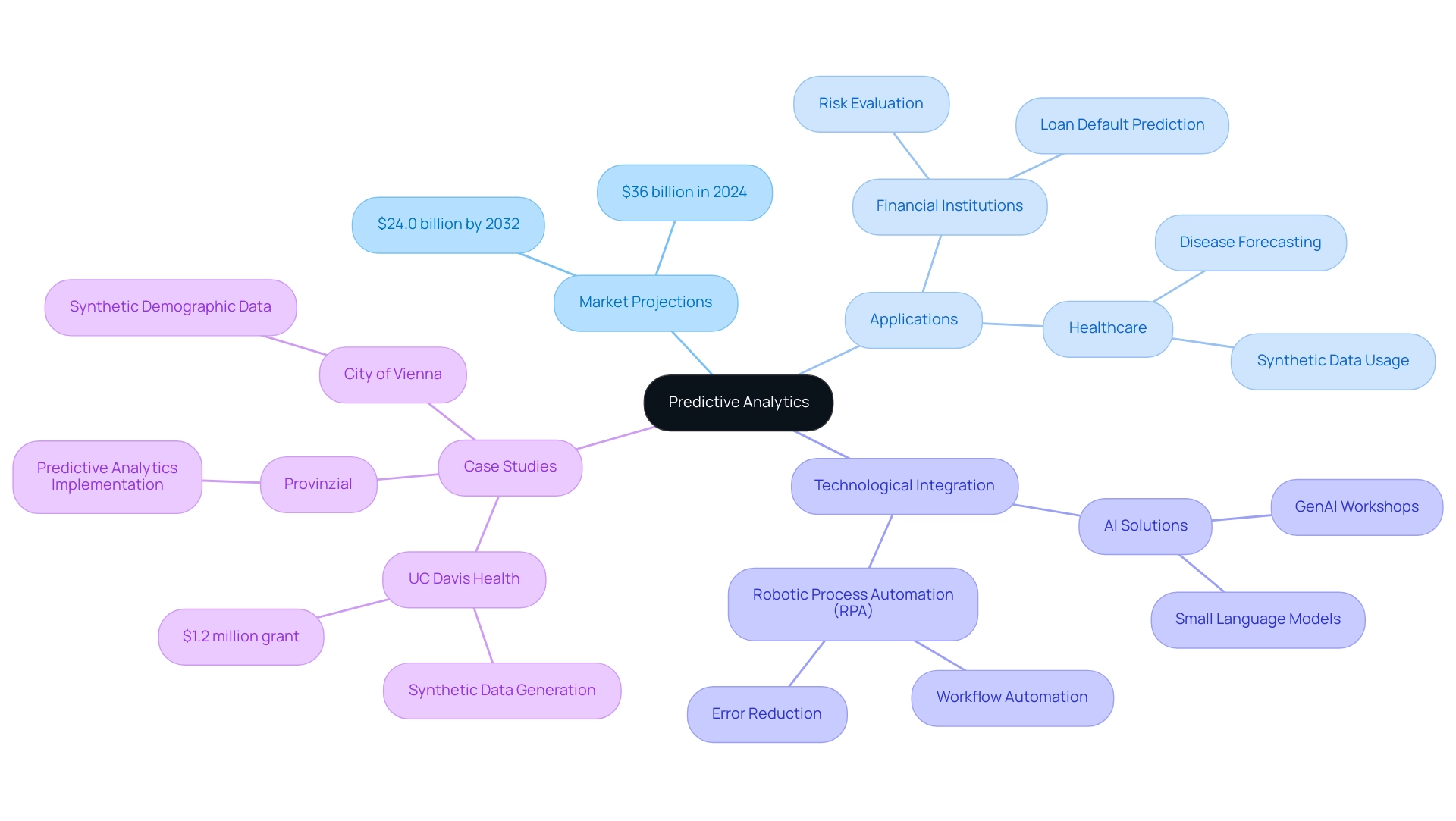
Prescriptive Analytics: What Should We Do Next?
Prescriptive analysis stands out as a transformative tool that provides actionable recommendations derived from comprehensive data examination. By synthesizing insights from various types of data analytics, including descriptive, diagnostic, and predictive data analysis, it empowers organizations to identify the best courses of action. For instance, supply chain managers can leverage prescriptive data analysis alongside Robotic Process Automation (RPA) to optimize inventory levels necessary to satisfy customer demand while simultaneously reducing costs.
This combination not only streamlines operations but also maximizes resource allocation and enhances overall productivity. Recent statistics suggest that the prescriptive data analysis market is projected to expand at a remarkable CAGR of 26% from 2024 to 2033, reflecting its growing importance in business strategies. The financial consequences of adopting prescriptive data analysis and RPA are considerable, as companies can achieve substantial cost reductions and efficiency improvements.
As organizations adopt a use case-driven approach to address quality issues, they can prioritize improvements effectively, further enhancing decision-making processes. Additionally, experts in supply chain management advocate for prescriptive analysis in conjunction with tailored AI solutions, highlighting its potential to optimize operations and drive efficiency. IBM Corporation’s recent acquisition aims to expand its software portfolio across data, artificial intelligence, and automation, showcasing the industry’s direction towards comprehensive observability.
Moreover, the case study named ‘Planning for the Electric Future‘ demonstrates how entities can employ prescriptive data analysis in supply chain transformations, especially regarding sustainability and electric vehicle adoption. The integration of the latest tools for implementing prescriptive data analysis and RPA types of data analytics is essential for organizations aiming to capitalize on emerging trends, ensuring they remain competitive in a rapidly evolving landscape. Lastly, SAP SE’s financial performance underscores the financial implications of adopting prescriptive analytics and RPA in business strategies.
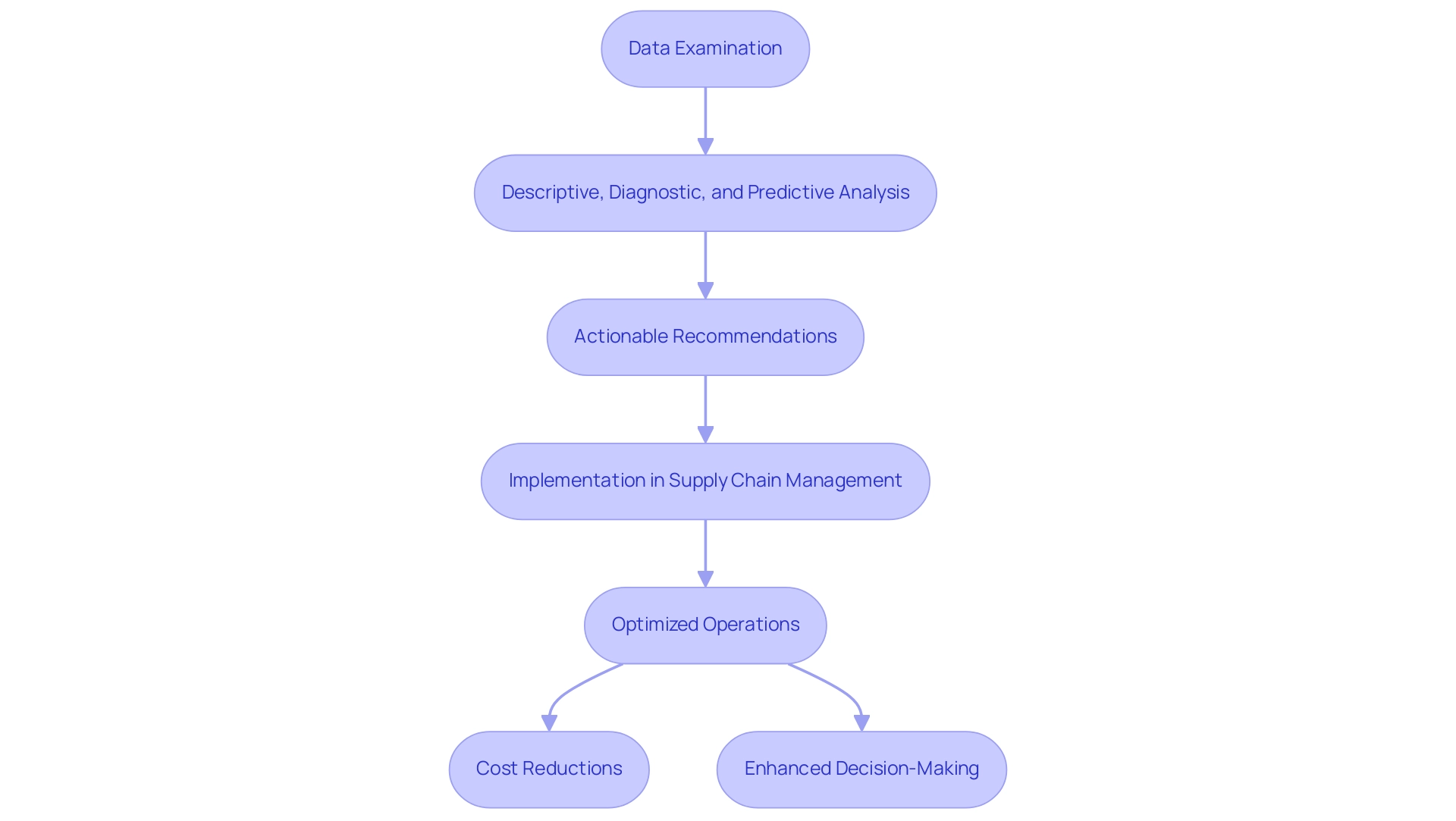
Conclusion
Embracing data analytics is no longer a luxury; it has become a necessity for organizations seeking to thrive in today’s competitive landscape. The exploration of descriptive, diagnostic, predictive, and prescriptive analytics reveals a structured approach to transforming raw data into actionable insights. Each type serves a unique purpose, enabling businesses to:
- Understand past performances
- Uncover underlying reasons for outcomes
- Forecast future trends
- Recommend strategic actions that align with organizational goals
Overcoming challenges such as data integrity and the complexities of advanced technologies like artificial intelligence is crucial for fully harnessing the power of data. Organizations that prioritize these aspects not only enhance their operational efficiency but also foster a culture of innovation and informed decision-making. Implementing robust analytics strategies can lead to significant improvements, as evidenced by successful case studies that demonstrate the tangible benefits of data-driven initiatives.
As the data landscape evolves, the integration of advanced technologies and tailored solutions will be pivotal in navigating the complexities of analytics. By leveraging these insights and embracing a comprehensive approach to data utilization, organizations can position themselves for sustained success in an increasingly data-driven world. The future belongs to those who are willing to harness the full potential of their data assets, turning challenges into opportunities for growth and excellence.
